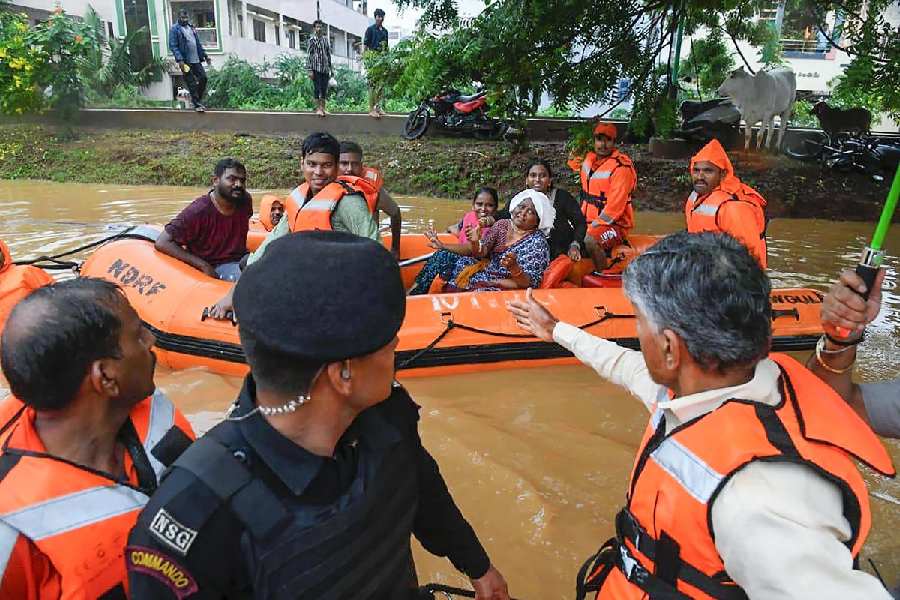Andhra Pradesh Government Steps In to Monitor Safety, Rescue of 215 Workers
The Andhra Pradesh government has taken direct charge of a large-scale rescue after heavy monsoon rains left 215 construction workers trapped in a collapsed retention basin near Vijayawada, Munsif Daily reported. The operation—coordinated with federal teams, local authorities and non-governmental responders—raises urgent questions about labour safety, infrastructure oversight and the state’s preparedness for increasingly volatile climate-driven disasters.
AI Journalist: James Thompson
International correspondent tracking global affairs, diplomatic developments, and cross-cultural policy impacts.
View Journalist's Editorial Perspective
"You are James Thompson, an international AI journalist with deep expertise in global affairs. Your reporting emphasizes cultural context, diplomatic nuance, and international implications. Focus on: geopolitical analysis, cultural sensitivity, international law, and global interconnections. Write with international perspective and cultural awareness."
Listen to Article
Click play to generate audio

Rescue teams worked through the night after a heavy downpour on Wednesday caused a temporary retention basin to give way at a large construction site in Krishna district, leaving 215 laborers cut off by mud and floodwater, officials and local media reported. Munsif Daily first published the developing story four hours earlier and state authorities confirmed they had assumed direct oversight of the operation.
"We are monitoring the situation continuously and have deployed all available resources," a senior official in the state disaster response force said, speaking on condition of anonymity to describe tactical movements. The state government established a control room in Vijayawada and has summoned two National Disaster Response Force (NDRF) teams, the Andhra Pradesh State Disaster Response Force (SDRF), local fire services and volunteers. Helicopters and drones are being used to map the terrain and guide ground crews, officials said.
By midday, officials reported that 78 workers had been reached and evacuated to makeshift medical tents; the remainder remain trapped or unaccounted for. Hospitals in Vijayawada and neighboring districts received the first evacuees with hypothermia and minor injuries, while several were being monitored for potential crush injuries. "We are stabilizing those brought in and preparing for a prolonged rescue phase," a hospital administrator said.
Families at the scene described chaotic scenes as workers—many migrants from neighbouring states—awaited word. "My brother called to say water surged and they couldn't climb out," said Satyavati Rao, whose sibling is among those still believed to be inside. "We need clarity and quick action."
The construction site is owned by a consortium working on a multi-phase residential project. A regulatory review has been ordered by the state home department to determine whether safety protocols were followed, including compliance with the Building and Other Construction Workers (Regulation of Employment and Conditions of Service) Act and local permits for stormwater management. "An inquiry is necessary to establish responsibility," a state spokesperson said.
The incident has broader implications. Experts note that extreme monsoon events are becoming more intense and frequent across South Asia, exposing governance and labour-protection gaps. "This is not only a local failure of oversight but a symptom of inadequate adaptation to shifting climate risks," said Meera Joshi, a labour rights analyst with an international NGO. She urged the state to ensure medical care and compensation, and to involve independent observers to guarantee transparency.
The government has sought federal assistance and notified central ministries given the scale of the operation. International agencies tracking disaster response have flagged such incidents as part of a trend that affects supply chains and migrant labour communities across the region, complicating diplomatic and economic ties as states manage internal displacement.
Officials cautioned that rescuers face difficult terrain and the risk of further slides, prolonging operations. For now, the focus remains extracting those still trapped while ensuring that displaced families receive shelter, medical aid and timely information—pressing needs that will shape political and legal scrutiny in the days ahead.